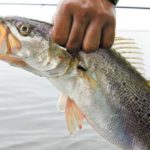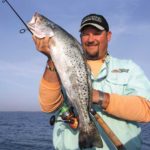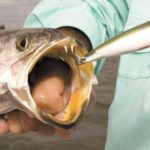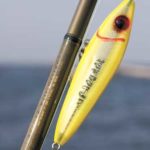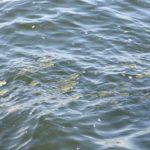
If you want to catch schoolies, fish the deep holes, but if leg-length speckled trout are on your mind, go to Hopedale’s redfish flats.
Wherever there are fish to catch or animals to shoot, there are anglers and hunters who prefer to forego catching just any fish or shooting just any animal in favor of securing the bragging rights that come with catching the biggest fish or shooting the biggest animal.
Rather than feeling compelled to compensate for any other shortcomings, most of these anglers and hunters are more attracted to the challenges that come along with outwitting the strongest of the survivors.
Capt. Charlie Thomason with Bayou Charters is one such angler. Thomason, a well-known redfish tournament angler and Hopedale fishing guide, knows he could easily slide into the crowds at Oak River, Orange Bayou and the Twin Pipelines, and catch all the speckled trout he wanted this winter.
However, he also knows that nearly every one of those trout would range from 10 to 14 inches. Rather than head to the main areas where everybody else tries to catch trout in 15 to 20 feet of water, Thomason points his Triton bay boat directly at where he had been catching redfish all summer long — the shallow marshes where he finds 5- to 7-pound trout in 1 to 3 feet of water.
“Sometime by the end of November or the first part of December, these trout will just show up from nowhere,” Thomason said. “These fish are mainly coming in from the outside areas like Black Bay, some from Breton Sound and from the MRGO. These trout come up through Bayou La Loutre, and they just kind of spread out from there.”
Why are these trout making the move from the outer bays into the shallow marshes? Thomason believes they make the move because the water in the outer bays just doesn’t have the warming ability the inside water does.
“In other words,” he said, “once the water out in Black Bay gets cold, it stays cold. The water on the inside gets cold at night, but trout know that the shallow bays on the inside are going to warm up during the day. Being cold-blooded creatures, they know they aren’t the only ones that are going to warm as the water warms.
“They know all those mullet are going to be feeling just as warm. Trout move into this shallow water during the middle of the day because they know they’re going to have a higher success rate when it comes to eating.”
While trout will spend a good portion of each 24-hour period stacked up in the deeper canals and bayous, Thomason says that this isn’t exactly where anglers should be fishing — even though it’s possible to catch trout when they’re deep.
Take Bayou La Loutre, for example. Many of the fish that move in will make their way up this bayou that runs directly in front of Thomason’s dock in Hopedale, but heavy boat traffic will make them hug the bottom and feed on bait coming through when the opportunity is there.
“You can catch fish early in the day when they’re still in the deeper holes,” Thomason said, “but normally the best time to fish is from 8:30 in the morning to about 2 in the afternoon. Mid-day fishing is always more successful in this area.”
Before the fish move in for their mid-day feed, many of them will stack up on the edges of the drops-offs that lead from the bayous to the flats. Thomason says anglers can catch them while they are grouped up, but it requires a total commitment to change tactics.
“If you want to fish early, you should slow down a bunch,” he recommended. “You can’t throw a bait out there and work it back like you normally would if you want these fish to bite. Whatever you consider as fishing a lure slow right now, slow down even more than that.”
Of course, the question is why would anybody want to spend time slowly fishing these deeper holes when the action will heat up on the flats later in the day. The trout stack up knowing they are about to move on to the flats to eat, so waiting for them to make their move can result in more consistent action.
“Even though it’s more consistent on the flats once it warms up, you still need to approach this kind of fishing with a different mindset,” Thomason cautioned. “The whole key is understanding that you’re not going to smoke the fish.
“This is the kind of fishing where you’re going to have the ability to catch fewer but larger fish than what everybody else is catching. Everybody fishing the community holes may be catching more than you, but it’s going to take 15 of their fish to equal two of yours.”
Being that Thomason is fishing places where he would normally be fishing for redfish, one of the first things he ties on is a topwater like a MirrOlure Top Dog Jr. or She Dog. This isn’t anything like regular topwater fishing, though, because it requires the patience of a saint.
The best topwater retrieve for these shallow trout, according to Thomason, is to click your lure to one side then wait about two or three seconds before clicking it back to the other. Working it really slowly like this gives these generally lethargic fish that are looking to feed ample opportunity to decide that they just can’t let this big mullet go by.
“And finding mullet is the entire key to this kind of fishing,” Thomason said. “Mullet are more key than current, tide or anything else this time of year. If the mullet are there, the fish are there. Pulling into a pond only to discover that there aren’t any mullet there while you’re drifting through means things aren’t looking too good for you in that particular spot.”
Some of the best places in the Hopedale marsh to find mullet and big trout this December, January and February are Lake Amadee, all the ponds off the main Reggio Canal, Bayou LaChoute, Grand Lagoon, Tanasia Lagoon off of Amadee and Cochon Bay.
These places all have the requisite deep and shallow water combination that allows the fish to adjust without having to move very far. Thomason pointed out the ponds off of the Reggio Canal as a perfect example of what to look for.
“There are little passes and bayous that run all through that area that are 6 to 8 feet deep,” he said. “Right off that deep water, there are a bunch of ponds and flats that are 1 to 3 feet deep. This is the perfect example of a place where the trout can just pop up and down as the water warms and cools.”
Fishing trout in areas that are typically considered Hopedale redfish holes isn’t for just anybody. This is the kind of fishing that takes that certain kind of mindset that you’re going to go for the biggest a species has to offer rather than catch a bunch of smaller uneducated fish.
“It’s definitely more for people who want to go out and catch 10 big trout as opposed to 60 small trout,” said. “If you’re looking for a quality fishing experience rather than quantity, then you should give this a try. Don’t give up on it too early by switching to a popping cork. You’ll catch fish under a cork, but they aren’t going to be much to brag about.”
Contact Capt. Charlie Thomason at 504-278-FISH or visit www.captaincharlie.com.
